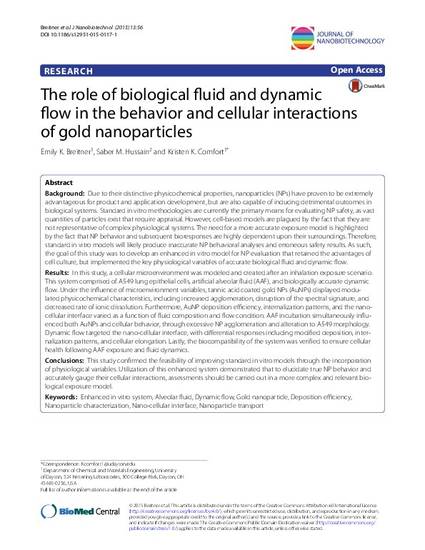
Background: Due to their distinctive physicochemical properties, nanoparticles (NPs) have proven to be extremely advantageous for product and application development, but are also capable of inducing detrimental outcomes in biological systems. Standard in vitro methodologies are currently the primary means for evaluating NP safety, as vast quantities of particles exist that require appraisal. However, cell-based models are plagued by the fact that they are not representative of complex physiological systems. The need for a more accurate exposure model is highlighted by the fact that NP behavior and subsequent bioresponses are highly dependent upon their surroundings. Therefore, standard in vitro models will likely produce inaccurate NP behavioral analyses and erroneous safety results. As such, the goal of this study was to develop an enhanced in vitro model for NP evaluation that retained the advantages of cell culture, but implemented the key physiological variables of accurate biological fluid and dynamic flow.
Results: In this study, a cellular microenvironment was modeled and created after an inhalation exposure scenario. This system comprised of A549 lung epithelial cells, artificial alveolar fluid (AAF), and biologically accurate dynamic flow. Under the influence of microenvironment variables, tannic acid coated gold NPs (AuNPs) displayed modulated physicochemical characteristics, including increased agglomeration, disruption of the spectral signature, and decreased rate of ionic dissolution. Furthermore, AuNP deposition efficiency, internalization patterns, and the nano-cellular interface varied as a function of fluid composition and flow condition. AAF incubation simultaneously influenced both AuNPs and cellular behavior, through excessive NP agglomeration and alteration to A549 morphology. Dynamic flow targeted the nano-cellular interface, with differential responses including modified deposition, internalization patterns, and cellular elongation. Lastly, the biocompatibility of the system was verified to ensure cellular health following AAF exposure and fluid dynamics.
Conclusions: This study confirmed the feasibility of improving standard in vitro models through the incorporation of physiological variables. Utilization of this enhanced system demonstrated that to elucidate true NP behavior and accurately gauge their cellular interactions, assessments should be carried out in a more complex and relevant biological exposure model.
Available at: http://works.bepress.com/kristen-comfort/3/

This article is distributed under the terms of the Creative Commons Attribution 4.0 International License (http://creativecommons.org/licenses/by/4.0/), which permits unrestricted use, distribution, and reproduction in any medium, provided you give appropriate credit to the original author(s) and the source, provide a link to the Creative Commons license, and indicate if changes were made. The Creative Commons Public Domain Dedication waiver (http://creativecommons.org/ publicdomain/zero/1.0/) applies to the data made available in this article, unless otherwise stated.
Permission documentation is on file.